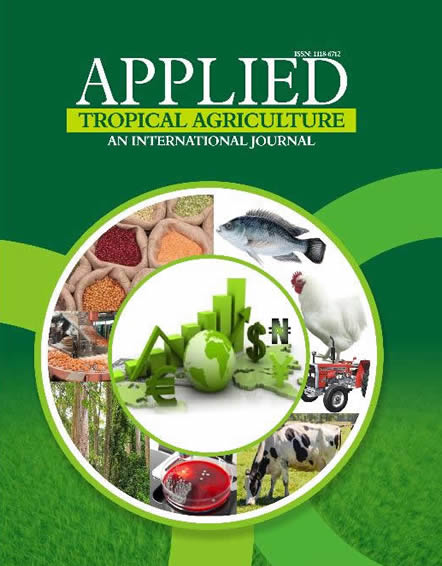Field evaluation of the effect of variety and poultry manure application rates on the relative abundance of insect pests of
pigeon pea, Cajanus cajan, was carried out at the Teaching and Research Farm of the School of Agriculture and
Agricultural Technology, Federal University of Technology, Owerri, southeastern Nigeria. The trial was laid out in a 2 x 5
factorial arrangement fitted into a Randomized Complete Block Design. Two (2) varieties of pigeon pea, locally called
“Gammu gammu” and “Chorie”, were treated with five levels of poultry manure (PM) at 0.00 (control), 1.80, 3.60, 5.40
and 7.20 kg/plot and replicated four times. Seeds were planted at a spacing of 30 cm x 60 cm (55,556 plants ha-1).
Percentage seed emergence was recorded after 50 % emergence and insect pest sampling was carried out weekly from the
third week after sowing. Leaf damage and other growth parameters (number of leaves and branches) were carried out at
3, 6 and 9 weeks after planting (WAP). Yield measurement parameters (pod, seed and shell weights) were assessed. Major
insect pests of pigeon pea at vegetative phase identified, in order of importance, were; Leptualaca fassicollis Thoms (leaf
beetles), Empoasca facialis Jacobi (Jassids, Green leaf hoppers), Aphis craccivora Koch (Aphids), Podagrica spp. Jacoby
(Flea beetles), Bemisia tabaci Gennadius (Whiteflies) and Zonocerus variegatus Linnaeus (Variegated grasshoppers).
Major flower and pod-damaging insects were; Helicorverpa armigera Hübner (Pod borers), Mylabris pustulata Thunberg
(Blister beetles), Nezera viridula Linnaeus (Southern green stink bugs), Riptortus dentipes Fabricius (Pod-sucking bugs),
Maruca vitrata Fabricius (Bean pod borers) and Anoplocnemis curvipes Fabricius (Coreid bugs), in that order. There were
no significant differences between the varieties but increased rate of poultry manure application led to increases in the
number of branches, buds and leaves and also had a significant effect on leaf damage. Plants treated with highest rate of
poultry manure (7.20 kg), in both varieties, tolerated insect attack and had more leaves, branches and yield (pod, seed and
shell weights) than those treated with 3.60, 1.80 and 0.00 kg respectively. It may be concluded that the cultivation of
pigeon pea with poultry manure, in a humid tropical environment, will increase yield and tolerance of the crop to insect
pest attack..
PAPER TITLE :INFLUENCE OF POULTRY MANURE APPLICATION ON INSECT PESTS OF TWO VARIETIES OF PIGEON PEA [CAJANUS CAJA
APPLIED TROPICAL AGRICULTURE | VOLUME 21 NUMBER 3 2016
Paper Details
- Author(s) : Ojiako, F.O.1*, Zakka, U.2, Kayode, R.M.O.3 and Offor, C.S.1
- Abstract:


